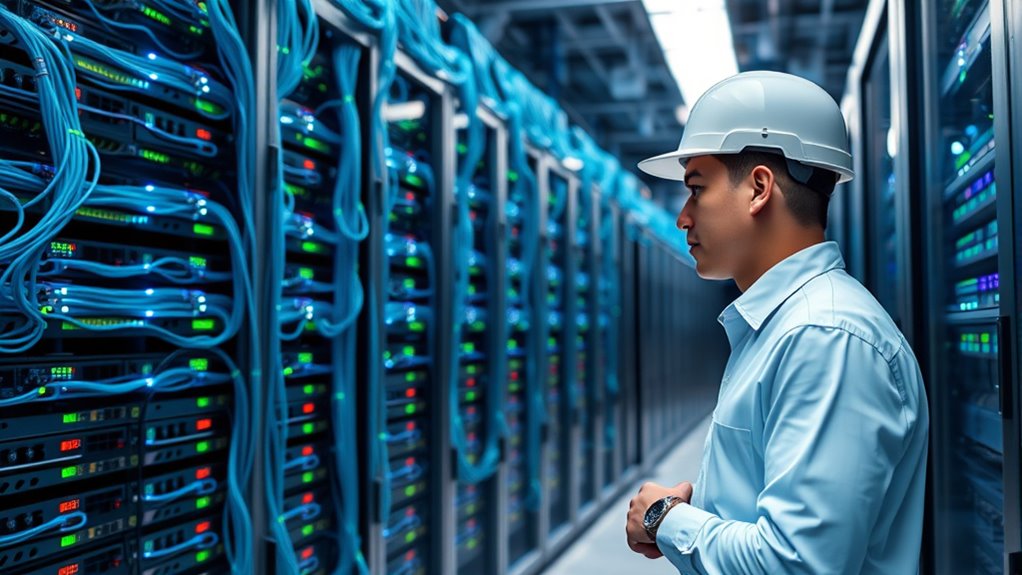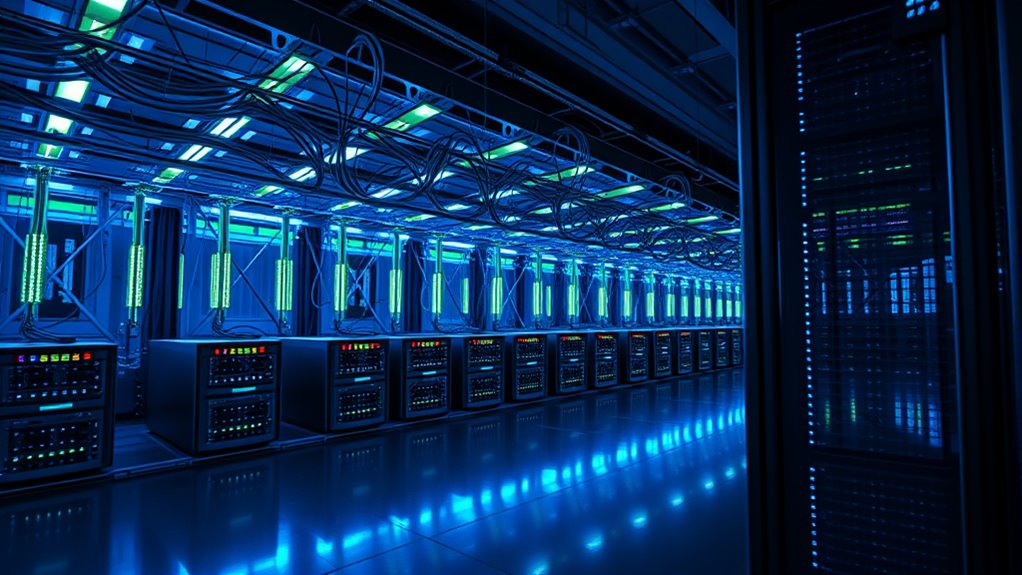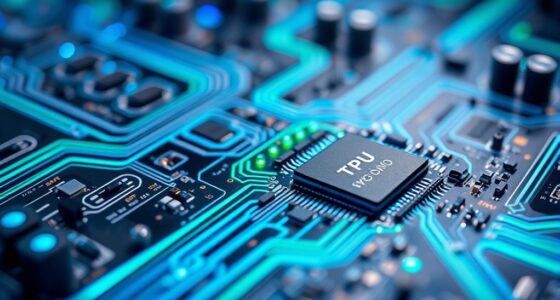Edge orchestration helps you manage workloads across distributed nodes to boost performance, security, and real-time responsiveness. It constantly monitors the health and capacity of each device, dynamically adjusting workload distribution to avoid congestion or failures. By processing data locally, it reduces latency and bandwidth use. It also enforces security policies to protect sensitive information. Keep exploring to discover how this system efficiently coordinates a complex network of devices for seamless, reliable services.
Key Takeaways
- Edge orchestration distributes workloads dynamically across multiple nodes to optimize performance and resource utilization.
- It monitors node health and capacity to adapt workload distribution in real-time, ensuring system resilience.
- Automated decision-making prioritizes critical tasks, reducing latency and enhancing response times for real-time applications.
- Security policies and encryption protect data integrity and privacy across distributed edge devices and servers.
- It coordinates devices and applications seamlessly, enabling efficient, secure, and low-latency edge-based services.

Have you ever wondered how smart devices and complex applications work seamlessly at the edge of a network? It’s because of a sophisticated process called edge orchestration. This system manages how workloads are distributed across various devices and servers located close to the data sources—think of sensors, cameras, or local servers—ensuring everything runs smoothly without constant reliance on centralized data centers. When you interact with a smart home device or stream a high-definition video, edge orchestration makes sure these activities happen quickly and reliably by intelligently balancing the load across multiple nodes.
At its core, edge orchestration involves coordinating numerous distributed nodes to handle different tasks efficiently. Instead of sending every bit of data to a distant cloud, workloads are processed locally when possible. This reduces latency, improves response times, and cuts down on bandwidth use. You probably notice this when a smart security camera detects motion and immediately sends an alert—you’re getting instant updates because the processing happens right at the edge, not somewhere far away. Or consider autonomous vehicles that need real-time data processing; edge orchestration ensures they react instantly to their environment by distributing tasks across nearby processing units.
Managing these workloads isn’t as simple as just dividing tasks among devices. It requires a dynamic system that adapts to changing conditions—like network congestion, device failures, or fluctuating workloads. Edge orchestration platforms continuously monitor the health and capacity of each node, then decide where to assign new tasks. They prioritize critical operations, such as safety alerts or real-time analytics, ensuring they get the resources they need without delay. This level of control demands sophisticated algorithms and automation tools that can make decisions on the fly, often without human intervention.
Security is another crucial aspect. Since workloads are distributed across many devices and locations, edge orchestration must ensure data remains protected. It enforces security policies, encrypts sensitive information, and authenticates devices to prevent breaches. You can think of it as a traffic controller, directing data safely and efficiently through a busy network of nodes. This helps maintain privacy and compliance, especially when handling personal or sensitive information.
Furthermore, effective edge orchestration relies on understanding recognizing and identifying recurring patterns in data and network behavior, which allows for more intelligent workload management. Ultimately, edge orchestration orchestrates a complex symphony of devices and applications working in harmony. It ensures that workloads are allocated smartly, resources are used efficiently, and services remain reliable and fast. For you, this means experiencing seamless, real-time interactions with smart devices, efficient data processing, and enhanced security—no matter how many devices or applications are involved. It’s the unseen backbone making modern, connected experiences possible at the edge of the network.
Frequently Asked Questions
How Does Edge Orchestration Impact Data Privacy?
Edge orchestration enhances data privacy by processing sensitive information locally on edge devices, reducing the need to transfer data to central servers. You can control where data is stored and processed, minimizing exposure risks. By implementing strict access controls and encryption during data handling, you guarantee privacy is maintained. Overall, edge orchestration helps you protect user data more effectively while maintaining system performance and compliance with privacy regulations.
What Are the Key Challenges in Implementing Edge Orchestration?
Think of orchestrating workloads like conducting a symphony—you must coordinate diverse instruments across different locations. Your key challenges include ensuring seamless communication among nodes, managing latency issues, and maintaining consistent security protocols. You also need to handle dynamic workload distribution and scalability, all while reducing system complexity. If you overlook these elements, your orchestration might falter, leading to inefficiencies and potential security vulnerabilities in your distributed environment.
How Does Latency Affect Workload Management in Edge Environments?
Latency directly impacts your workload management by delaying data processing and response times. When latency is high, you struggle to deliver real-time services, causing performance issues and user dissatisfaction. To manage workloads effectively, you need to minimize latency through optimized network architecture and edge devices. By doing so, you guarantee faster data processing, better resource allocation, and improved overall system responsiveness, which is vital for mission-critical applications.
What Hardware Requirements Are Needed for Effective Edge Orchestration?
While it’s tempting to think you need cutting-edge hardware, effective edge orchestration actually requires versatile, reliable devices. You’ll want robust processors, ample memory, and fast storage to handle diverse workloads smoothly. Network interfaces should support high-speed data transfer, and energy efficiency is key to guarantee operational costs. Additionally, scalable hardware solutions ensure your system adapts effortlessly as your edge environment grows, keeping performance steady and workloads balanced.
How Does Edge Orchestration Integrate With Existing Cloud Infrastructure?
You integrate edge orchestration with your existing cloud infrastructure by deploying orchestration tools that connect edge devices with your cloud platform. These tools enable seamless data flow, workload management, and automation across both environments. You can use APIs and standardized protocols like MQTT or REST to guarantee interoperability. This integration allows you to optimize resource use, improve responsiveness, and maintain centralized control, all while leveraging the benefits of distributed edge computing.
Conclusion
As you orchestrate workloads across scattered nodes, imagine a symphony where each instrument plays in harmony, no matter how far apart. With skilled edge orchestration, you become the conductor guiding data streams through a sprawling landscape, ensuring seamless performance. The digital orchestra you lead transforms chaos into melody, turning fragmented resources into a unified masterpiece. Embrace this power, and watch your distributed infrastructure dance smoothly to your command.









